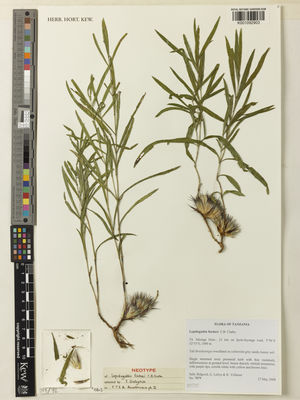Geography and distribution
This species is fairly widespread in the fire-prone miombo woodlands and montane grasslands of eastern Africa, occurring in southern Tanzania, Zambia, south-eastern Democratic Republic of Congo and northern Malawi.
Miombo woodland is characterised by the dominance of Caesalpinioid legume trees, most notably Brachystegia species, and has a more or less continuous grassy ground cover. It dominates large swathes of eastern Africa where rainfall is moderate but highly seasonal.
Regular dry-season fires play an important role in this ecosystem. A large number of species are adapted to these conditions in having large, woody, underground rootstocks which survive the burning. The annual shoots are produced either immediately after burning or after the following rainy season. The latter is typical for Lepidagathis fischeri which tends to flower following the main rainy season, although plants occasionally send up flowering shoots immediately after burning and before the leaves develop.
Description
Overview: A herb producing trailing, ascending or erect, annual, leafy stems up to 40 cm long from a woody, perennial base and rootstock. The flowers are held in a dense, basal head or cushion, sometimes also with smaller heads at the lower leaf nodes.
Leaves: The leaves are unstalked and vary from linear to broadly elliptic, are 1.5-13 × 0.1-3 cm, and have three (rarely five) prominent veins running from the base, although only the midrib might be prominent in linear-leaved forms. The leaf surfaces are hairless or with scattered, long, white hairs.
Flowers: The inflorescences are very complex, containing many flowers held on one-sided spikes, which are aggregated together. The bracts are thin and quickly become dry and brown, though often have purple tips. They are lance-shaped with a narrow, tapered tip and are 11-26 × 2.5-6.5 mm, and usually have long, dense, white hairs along the margin. Immediately below each flower is a pair of bracteoles that are similar to the bracts but narrower (to 3.5 mm wide). The calyx is green with brown or purple tips and is divided into five lance-shaped lobes, 10-19 mm long. The dorsal (back) lobe is longest and widest, the lateral two lobes being narrowest, each with a linear tip and with long, white hairs along the margin and shorter hairs on the surface. The flower is 11-18 mm long and is two-lipped above a short tube, the lower lip being three-lobed, the upper lip being hooded. It is white or pale purple with yellow or orange markings centrally and red or purple markings towards the margin on the lower lip and throat. The lower lip also has two lines of dense, silky hairs running either side of the centre. There are four stamens, the lower pair longer than the upper pair, each with two-celled, hairy anthers.
Fruits: The fruit is a two-seeded, hairless capsule, 8-9 mm long, splitting into two valves with each seed held on a hook which helps to fling it from the fruit as it explodes open. The seeds are covered in long, silky, creamy-brown hairs.
Lepidagathis fischeri is a typical member of the genus Lepidagathis , which is recognised by the combination of a two-lipped flower with four stamens in two pairs of unequal length, a two- or four-seeded capsule lacking a narrowed basal stalk (stipe) and with hairy seeds, and usually having one-sided (scorpioid - the axis typically curved like a scorpion's tail) inflorescence units. Lepidagathis falls into the tribe Barlerieae of the Acanthaceae, together with the much larger genus Barleria .
Hybridisation and the miombo woodlands
Lepidagathis fischeri is one of a group of very closely related species of Lepidagathis that occupy the woodlands and grasslands of eastern Africa and almost certainly hybridise freely in parts of their range, presenting a difficult challenge for plant taxonomists. Such species complexity is rather common in the miombo ( Brachystegia ) woodlands, which is a relatively young habitat in terms of evolutionary history and is therefore still actively evolving.
Threats and conservation
Lepidagathis fischeri is not uncommon in suitable habitat within its range and appears to benefit from moderate disturbance, favouring bare, open ground, where it can compete for light and where its basal flowers are accessible to insect pollinators. Indeed, it is commonly encountered along the edges of dirt tracks.
Although high human population pressure has led to some habitat destruction in parts of its range, it is not considered threatened and no specific conservation measures appear necessary.
This species is not currently represented in any seed bank.
Cultivation
Although not currently cultivated, Lepidagathis fischeri would make an interesting curiosity in tropical gardens, with its unusual inflorescences and intricately patterned flowers. This also applies to some of its close relatives such as L. andersoniana and L. eriocephala , both of which have even more strikingly coloured and patterned flowers and a more erect habit.
This species at Kew
Lepidagathis fischeri is well-represented in the collection of pressed and dried specimens housed in Kew's Herbarium. The original type specimen of this species, housed in the Berlin Herbarium, was destroyed when the building was bombed during the Second World War. A replacement type specimen was therefore recently selected on which to base our future understanding of this species, and this is housed in Kew's Herbarium.
The details, including images, of specimens of many other Lepidagathis species can be seen online in Kew's Herbarium Catalogue.






